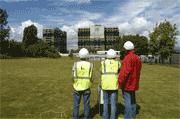
| Hirwaun | |
| The village of Hirwaun grew from the need to provide houses and services for the workers at the Hirwaun Ironworks that was founded by John Mayberry in 1757. Although the Works themselves were constructed on the North Bank of the River Cynon in the Parish of Penderyn, Breconshire, the village itself grew on the Southern Bank of the Cynon in the Parish of Aberdare. The River Cynon marking the boundary between the parishes and, hence, the counties. | |
| The Ironworks had a chequered early history and the development of Hirwaun was relatively slow. In 1813 the village contained 64 houses near the works, 5 at Penhow and 38 at Coedcae'rfelin. When the Ironworks were bought by the Crawshay Family in 1819 there followed a short lived period of prosperity, but this was followed by the depression of 1829 that led to unemployment and a cut in wages. During the Merthyr Rising of 1831a red flag was raised at Hirwaun, apparently the first time this banner was raised in Britain.
Right: High Street Hirwaun |
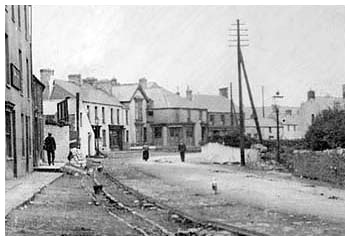 |
| Despite these problems the period that the Ironworks were owned by the Crawshay Family were the most prosperous in their history. For much of this time the Ironworks were managed by Francis Crawshay. Somewhat eccentric, this ironmaster was well respected by his workers. He is said to have learnt Welsh and to have foregone living in Ty Mawr, the large house built in 1784 by Anthony Bacon, instead residing in a small cottage he had built at Tir Gwyn Bach. He is best known for his construction of Crawshay's Tower on the hillside overlooking Hirwaun. The Tower was built circa 1848 and measured 30 feet in height with an internal diameter of 12 feet. There were three floors with one room on each floor, one door and six round windows. The Tower fell into ruin following the departure of the Crawshay Family in 1859. | |
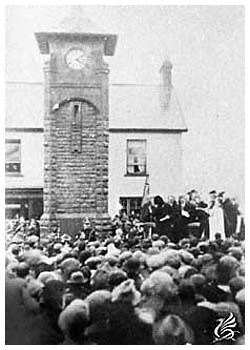 |
The opening of the Vale of Neath Railway from Swansea to Aberdare in September 1851 provided the next impetus for growth in Hirwaun. The main railway station was built to the North of the Village in the Breconshire area and this appears to have stimulated the construction of housing in that area, probably to house railway workers. St Lleurwg's Church was consecrated and opened by the Bishop of Llandaff in July 1858. The chapels such as Nebo, Bethel and Soar that the earlier, mainly Welsh, inhabitants had used as places of worship had opened earlier in the 1820's. A Brickworks also opened near the Station in 1852 and became an important employer in Hirwaun for many years to come until it eventually closed in 1973. Left: Unveiling of the War Memorial January |
| The remainder of the Nineteenth Century was generally prosperous for Hirwaun, although in common with the rest of the South Wales Coalfield the area suffered from the boom and bust trends inherent in the Coal Industry. Consequently, when the coal industry went into severe decline following the First World War Hirwaun suffered the same economic and social problems as communities throughout the Coalfield. These hardships were alleviated only by the outbreak of the Second World War, and in particular by the construction of the Royal Ordnance Factory to the West of the village, on the site that was later to become the Hirwaun Industrial Estate. During the 1960's two blocks of flats were built at Hirwaun which over a long period provided housing for many people and remained in use as residential properties until 30th May 2004 when RCT in partnership with the Controlled Demolition Group raised them to the ground with |
Animation images courtesy of |
| Hirwaun Ironworks | |
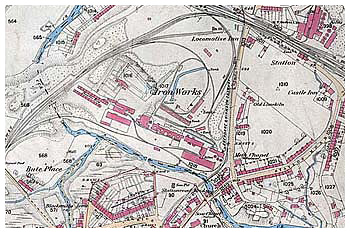 |
Hirwaun Ironworks, which was probably the first coke fired iron furnace in South Wales, was founded in 1757 by John Mayberry of Brecon when he leased land for 99 years from Lord Windsor. The works had a somewhat chequered history, passing through many changes of ownership, without any of the owners being able to return a good profit from their investment. The problems associated with the Hirwaun Ironworks became quickly apparent when in 1775 the initial partnership granted the lease to John Wasse and William King. However, this partnership failed to follow the conditions of the lease and after William King died insolvent the lease was terminated in 1777. |
The next owner of the site was Anthony Bacon of Cyfartha until his death in 1786. Thereafter the works were left to his sons Anthony and Thomas, when during their minority the works were leased to Samuel Glover of Abercarn by the Court of Chancery. During this period the works were probably producing about 500 tons of iron per annum. Shown right: The ruins of Hirwaun Ironworks at the end of the Nineteenth Century. The photograph clearly shows the four blast furnaces and to their right the building which housed the puddling furnaces and rolling mills. |
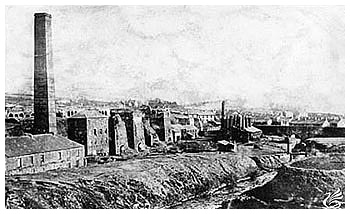 |
The next stage in the history of the ironworks began in 1819 when they were purchased by William Crawshay of Cyfartha. The period under the ownership of the Crawshay's was to be the most successful for the Hirwaun Ironworks, but problems did still arise. In 1820 the two furnaces were rebuilt and a beam blowing engine was constructed at the works by the Neath Abbey Iron Company. In 1824 another two furnaces were built on the site. Output figures increased dramatically during this period; in 1823 4,160 tons of iron were being produced, in 1826 the figure was 7,020 tons and by 1830 this had increased further to 9,370 tons per annum. |
|
| Hirwaun Coal Industry | |
| The area around Hirwaun and Rhigos has a long history of iron and coal working, reaching back at least as far as the Seventeenth Century. The opening of the Ironworks in 1757 provided further impetus to the industry, as coal was needed to provide coke for the blast furnaces. The growth of the sale coal market in the second half of the Nineteenth Century that provided the spur for the next stage in the growth of the coal industry in the Hirwaun area. During the second half of the Nineteenth Century a number of levels were opened on Hirwaun Common. These were usually short lived and relatively small concerns. | |
Among the larger collieries that worked the seams of Hirwaun Common were the Aberdare-Merthyr Steam Coal Colliery that operated from before 1860 to 1917 and the Bute Colliery. The Bute Colliery operated from before 1850, when it was owned by the Hirwaun Iron Company, until 1906. In 1883 a boiler exploded on the surface of the colliery killing one man. Picture right shows the damage caused by the Bute Colliery boiler explosion of 1883 |
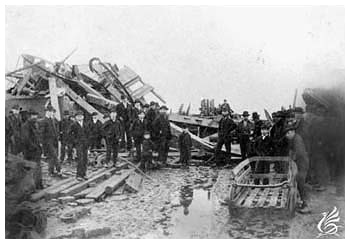 |
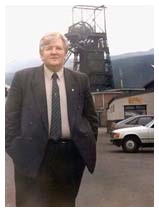 |
In recent years Hirwaun has again risen to prominence in the annals of coal mining in South Wales following the events at Tower Colliery in 1994. Faced with closure the miners opted to buy the colliery themselves. The scheme was funded by each of the 239 miners at the colliery pledging £8,000 each and on 23rd December 1994 the miners marched back to the colliery that they now owned. Since then Goitre Tower Anthracite Ltd. has prospered and now remains the last colliery working in the Cynon Valley. Left: Tyrone O'Sullivan at Tower Colliery |
| Tyrone O'Sullivan was the National Union of Mineworkers Branch Secretary during the miner's buyout of Tower Colliery. An influential leader of the movement to secure ownership of the Colliery he is now Chairman of Goitre Tower Anthracite Ltd. He was awarded an OBE in the 1996 New Years Honours List. | |
